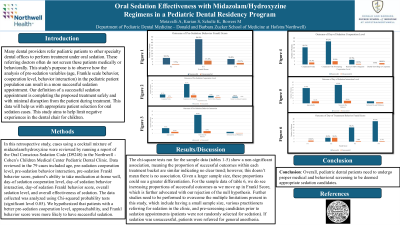Sedation
187 - Case Selection and Oral Sedation Effectiveness with a Midazolam/Hydroxyzine Regimen


Ariana Motavalli, DDS (she/her/hers)
Pediatric Dental Resident
Cohen Children’s Medical Center of Long Island Jewish Hospital, Queens, NY
Northwell Health Cohen Children's Medical Center
Manhasset, New York, United States- SK
Sheeba Kurian, DDS
Chief & Program Director
Northwell Health Cohen Children's Medical Center
New Hyde Park, New York, United States - KS
Kathleen Schultz, DMD
Northwell Health Cohen Children's Medical Center
- SK
Sheeba Kurian, DDS
Chief & Program Director
Northwell Health Cohen Children's Medical Center
New Hyde Park, New York, United States
Presenting Author(s)
Co-Author(s)
Program Director(s)
Purpose: This study's purpose is to observe how the analysis of pre-sedation variables in the pediatric patient population can result in a more successful sedation appointment. Our definition of a successful sedation appointment is completing the proposed treatment safely and with minimal disruption from the patient during treatment. This data will help us with appropriate patient selection for oral sedation cases to help limit negative experiences in the dental chair for children.
Methods: In this retrospective study, cases were reviewed by running a report of the Oral Conscious Sedation Code (D9248) in the Northwell Health Cohen Children’s Medical Center Pediatric Dental Clinic. Data was reviewed in 79 cases where a cocktail mixture of midazolam/hydroxyzine was used. Variables studied included age, pre-sedation cooperation level, pre-sedation behavior interaction, pre-sedation Frankl behavior score, patient’s ability to take medication at-home well, day-of sedation cooperation level, day-of sedation behavior interaction, day-of sedation Frankl behavior score, overall sedation level, and overall effectiveness of sedation. The data collected was analyzed using Chi-squared probability tests at a significance level of .05. We hypothesized that patients with a better pre-sedation cooperation level, approachability, and Frankl behavior score were more likely to have a successful sedation appointment.
Results: Our data showed a non-significant association between our pre-sedation variables and the rate of sedation success. Further studies need to be performed to overcome the multiple limitations present in this study.
Conclusion: Overall, pediatric dental patients need to undergo proper medical and behavioral screening to be deemed appropriate sedation candidates.
Identify Supporting Agency and Grant Number:

.jpg)